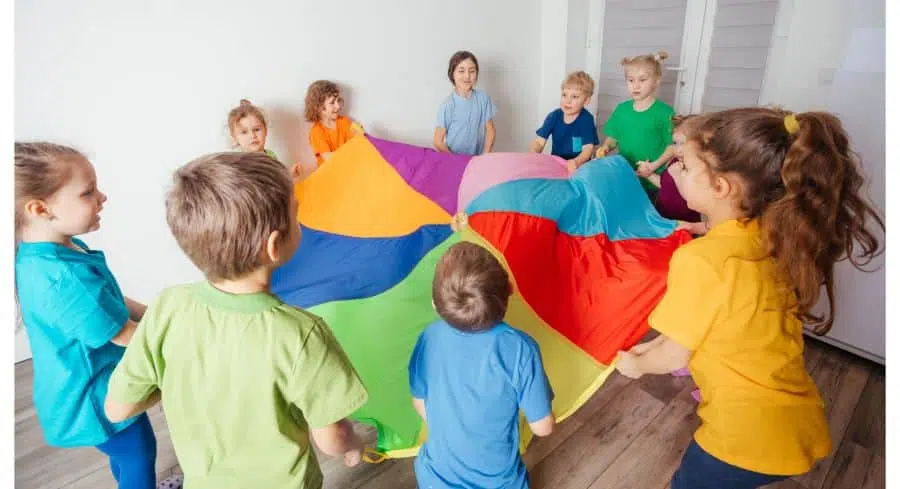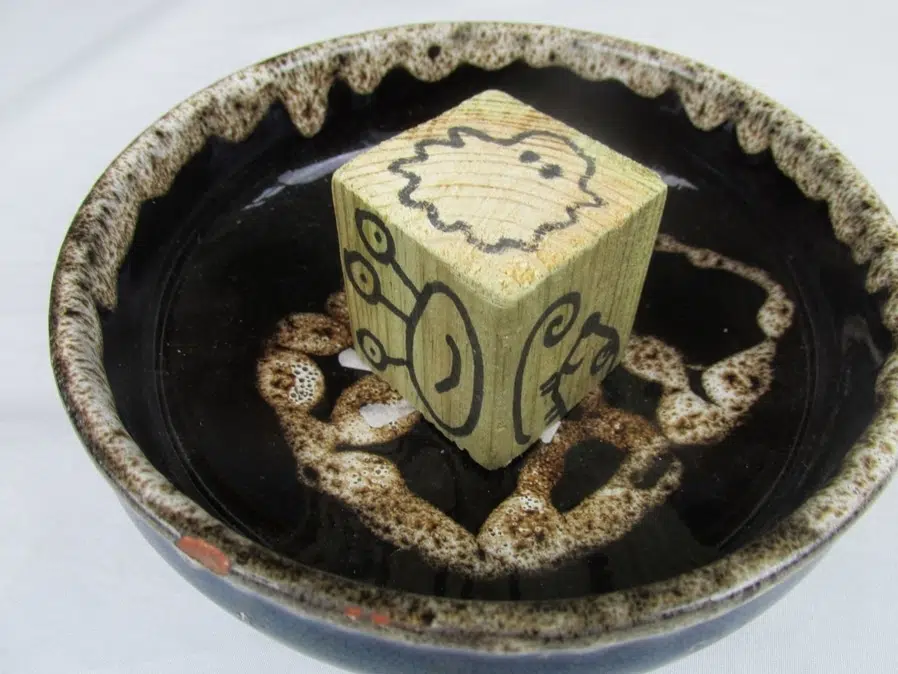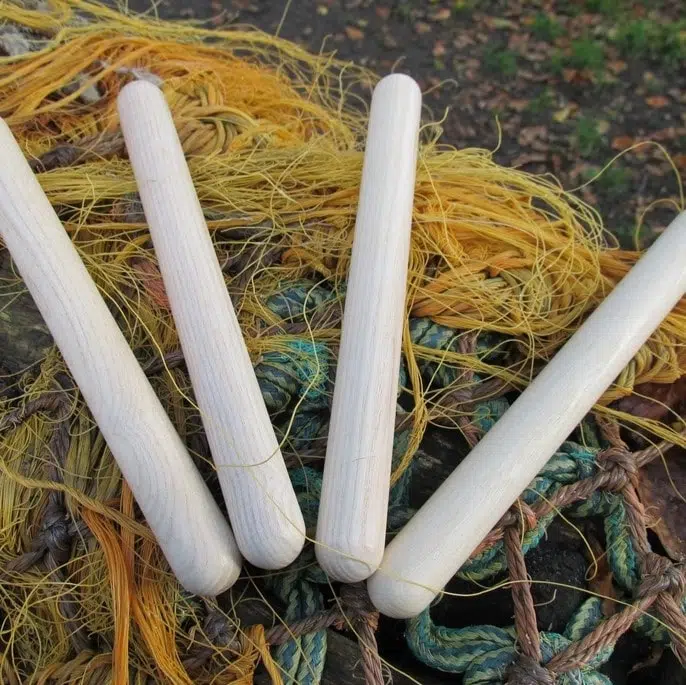We all know social times can be a bit tense in preschool, especially during start of the school year! I’ve taught this age group for more than a decade, and I know that children, especially younger students need lots of opportunities to relax and get to know those around them.
That’s where icebreaker games come in!
The best and most fun icebreaker games for preschoolers are:
- Funny Voice Names
- Imaginary Ball
- Name Memory Game
- Name Dance Boogie
- Fly!
- Copy Cat
- 1,2,3, Look!
- Hello songs
- Hit the Names
- Balloon Whack
- Emotions Round The Circle
- Roll The Ball – Thank You
- Roll The Ball – Questions
- Get To Know You Basket
- Get To Know You Jar
Let’s dive straight into the games…

1. Funny Voice Names
A lot of these ice breaker games have a playful side, as kids are much more able to ‘let go’ if they’re not disclosing too much of themselves to start with.
The funny voice game is a great one for learning everyone’s name. But it’s also fantastic for doing silly voices – and what kids don’t enjoy doing that!
Basically, sit in a circle to start with.
To go with the game, I have a simple wooden dice that I made out of a building block. It looks like this….

On each side, it has a picture of a character. It has:
- An alien
- A tiger
- A ghost
- A robot
- A princess
- A mouse
The first child in the circle is going to roll the dice, and say their name using that voice! Everyone else is going to copy.
So, if the kid was called ‘Charlie’, he’d roll the dice and see what he got. If it was a tiger, he would say, ‘Charlie in his best tiger voice! Everyone then copies!
Then pass the dice to the next person. They roll and say their name using whatever character that comes up on the dice.
Continue!
2. Imaginary Ball
This is a classic circle game, that I’ve always thought works well as an ice-breaker.
The students sit in a circle. The adult shows the children an ‘imaginary ball’. Describe how you are holding it in your hands!
Pretend to ‘pass’ it to the person next to you. They pass it to the next person, and so on.
This activity really encourages eye contact and cooperation.
If they get good at passing the ball, you can extend the game in any of the following ways:
- Bounce the ball to the person next to you
- ‘Throw’ the imaginary ball to a person across the circle. Say their name, throw it to them, and pretend to catch it.
- Pass some other imaginary things – like a feather, a balloon, a lead weight, and whatever else you can think of
3. Name Memory Game
This is another fun icebreaker activity for learning names. It also tests a key thinking skill – memory!
The children sit in a circle. Have something to pass around, like a stuffed animal toy, or a puppet.
The first child receives the object and says their own name. E.g. ‘Chloe’.
They pass the object to the next person. That second person will say the first person’s name, and then their own name. So it might be, ‘Chloe, Jake.’
Then they pass to the third person, who might say, ‘Chloe, Jake, Hassan.’
Continue just like this!
Probably about 6-8 people are the maximum number of kids for this game. Anything after this gets far too difficult.
If you have more kids, you could potentially split them up into separate circles to attempt the game.
4. Name Dance Boogie
Here’s another fun way of everyone learning the names of the others – but doing so in a way that is not intense, and where they can ‘let their hair down’ a bit as well.
The kids sit in a circle. The first child stands up. They are going to say their name, and do a dance that goes with it.
In an ideal world, they are going to break their name up into syllables, and do a dance move for each syllable.
So, if they were called ‘Hannah’, then the dance move might go:
‘Han-’ (swing your arms up) ‘-nah!’ (Swing your arms down).
Everyone is then going to copy, say the name, and do the action. Do lots of repetitions of the name, to get everyone feeling good and having fun!
Then the next child goes, inventing a set of moves to go with their name.
5. Fly!
This is a type of movement ice-breaker, where no talking is required. These are definitely the best type for children that don’t like to be put on the spot or talk in structured situations.
One child, or an adult, is going to give the instructions in this game.
They are going to say the name of a favorite animal or object, followed by the word ‘fly’.
If the thing in question does fly, then they do an impression of it. If it doesn’t fly, then they freeze.
So, if the person who is ‘it’ says, ‘Ducks fly!’ Everyone will flap their wings and go around quacking.
However, if they say, ‘Cats fly!’ they will freeze (because cats don’t fly).
Some great things that fly (just in case you can’t think of anything!) are things like:
- Planes (swooping and soaring)
- Helicopters (spinning their arms)
- Eagles (soaring slowly)
- Hummingbirds (flapping wings really fast)
6. Copy Cat
This is another movement activity and one of the best icebreaker games, that just seems to work well as an ice-breaker.
Play this game in a big space.
It probably makes sense for the adult to start by being ‘it’. You are going to act like an animal, and the kids are going to copy!
So, if you were going to be an elephant, you would stomp around, swing your arm for a trunk, have one arm as a big floppy ear, and all that kind of thing.
The kids copy.
They have to keep watching though because at any given moment you will swap animals!
You could suddenly transform into a chicken, for example, strutting around, flapping your wings, pecking, and making chicken noises!
It’s a really simple concept, but just great for releasing inhibitions and making everyone feel connected.
7. 1,2,3, Look!
This is a simple eye-contact circle game, where pretty much no talking is required (great for some kids).
Everyone sits in a circle, and they cover their eyes with their hands. Then everyone says, ‘1, 2, 3, look!’ They open their eyes and look at one person.
If that person is looking straight back at them, then they are both ‘out’ (in a good and fun way). They have ‘won’. Play several rounds, until everyone has experienced being looked at first and forming that connection.
8. Hello Songs
Singing songs is a great way for children to feel included socially.
There are all kinds of ‘hello songs’ you can access, but here’s the one I use the most:
To the music of Freres Jacques, sing to each child in turn in this way:
‘Hello, Jenny.’
Everyone waves, and sings, ‘Hello Jenny.’
‘Hello, Marcus.’
Everyone copies, ‘Hello Marcus!’
‘Hello, David.’
And so on and so on.
Generally speaking, lots of smiling, waving at each, eye contact, and singing, are all brilliant for helping children feel connected.
9. Hit The Names
This is another fun activity that experiences our names. It is also good for teaching syllables, and early phonics.
You need some rhythm sticks for this activity. These are just wooden sticks or claves, that look a bit like this…

I would say these are probably my very favorite early phonics resource, and you can do so many games with them.
Here’s the name game. Give out two sticks to everyone in the circle.
Then I sing the song, that goes like this (to the music of ‘London Bridge is Falling Down’):
Say your name around the ring
Around the ring, around the ring.
Say your name around the ring.
Say your name.
I get the kids to hit the rhythm sticks to the beat of the song.
Then one child goes first. They say their name, hitting the syllables of their name with the sticks, and then counting the syllables.
So, if their name was ‘Luca’, they would go ‘Lu-ca!’ (2 hits) ‘1, 2!’ (2 hits).
Everyone else copies, ‘Lu-ca! 1-2!’
Then the next person in the circle says their name.
The sticks just make it so much more interactive and engaging experience.
10. Balloon Whack
You can do the talking or the non-talking version of this!
The easier (non-talking) version goes like this – split the children into groups of between 4 to 6. The group stands together in a circle.
Have one fully inflated balloon for each group.
The easiest version is that one child will hit the balloon into the air where the group is standing. The child that is nearest where it goes to will hit it again.
Everyone will continue hitting the balloon up, and basically trying to stop it hit the floor!
The talking version is a bit trickier.
The child with the balloon will say another kid’s name in their group. They hit the balloon to them.
That child tries to catch it and say, ‘Thank you!’
They say someone else’s name, and the process repeats.
11. Emotions Round The Circle
This is a great circle game for thinking about emotions.
Have three simple ‘emotion cards’. You can very quickly draw these on three separate pieces of paper.
You need one smiley face on a piece of paper, one sad face, and one angry face.
Show the kids these faces, and place them in the middle of the circle.
One child goes first. They are going to stand up, and they are going to do one revolution of the circle, but moving in a way that represents one of the three emotions.
So, if they were happy, they might skip around, with a happy face. If they were sad, they might stalk around slowly, their shoulders hunched, a miserable expression on their face, and their arms drooping low!
The other kids are going to point to the emotion face that they think the child is demonstrating! They can describe why.
Then someone else has a go of representing the emotion.
12. Roll The Ball – Thank You
This is a very simple game that helps children learn good manners and how to say ‘thank you.’
Everyone sits in a circle for this one.
Have one large rubber or sponge ball. One child starts with this.
They pick someone in the, group, say their name, and roll the ball to them.
That person will hopefully receive the ball and say ‘thank you.’ Then they will say someone else’s name, roll it to them, and the structure will continue.
13. Roll The Ball – Questions
This is the slightly harder version of Roll The Ball – Thank You. In this fun icebreaker activity, you have one simple question that all the children are going to answer.
It might be:
- Say a food that you like
- Say a toy that you like
- Say a game that you like
Let’s say we choose ‘say a toy that you like.’
The first child says someone’s name and rolls the ball to them. They pick up the ball, say a toy they like, and choose the next child. They roll the ball to them.
The ball just helps to take the pressure off speaking. Having just one question is best, so children have lots of time to think of an answer.
14. Get To Know You Basket
For this game, you need some kind of basket and some small objects that you can hand out to the children.
I like to use pebbles.
Give the pebbles out, one to each child.
Then ask a very simple question. It might be, ‘What animals do you like?’
Then pass around the basket. The child that receives the basket will say what animal they like, put their pebble into the basket, and then pass it to the next child.
Top tip – if you think they might drop the basket, then the adult could hold it for them, and carry it around the circle.
15. Get To Know You Jar
This is a similar idea to the basket game.
Have a glass jar. Write some simple questions on cards, and place these in the jar. These are questions that the children should be able to answer about the lives, or their likes/dislikes.
They will be things like:
- What food do you like?
- What is your favorite animal?
- Who is your friend?
- Name someone that lives in your house.
Take one question out of the jar, ask it, and then get several children to answer it. Then get another question out, and repeat the process.
This is a really simple game, that even very young children can have a go of. It’s good for learning names, and also for basic manners as well (and saying ‘thank you’.)
Sit in a circle. Have one ball between the group.
One child says someone else’s name, and then rolls the ball to them. That child says, ‘Thank you.’
Then that child says someone’s name, and the process repeats. It’s as simple as that!
The hard bit, for many children, is remembering to say ‘thank you.’
You can make it harder for older children by getting them to throw and catch the ball.
